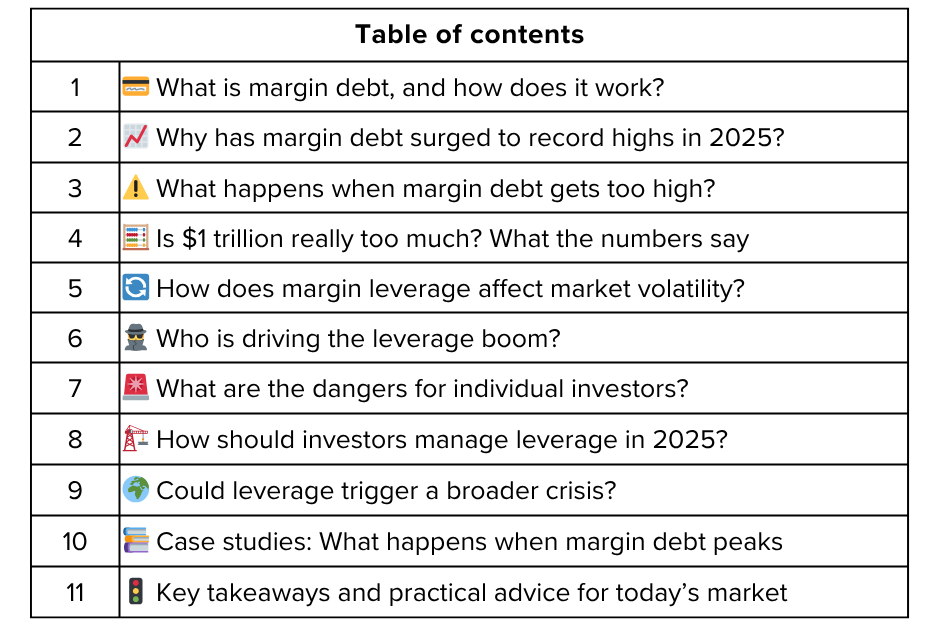Margin debt hits $1 trillion: Should investors worry about leverage?
A remarkable milestone has been quietly crossed on Wall Street: margin debt has surged past $1 trillion for the first time in history. As markets hit fresh highs in 2025, more investors are borrowing to amplify their bets. But with leverage at historic levels, the big question is: should you be worried? This guide will break down what margin debt is, why it has ballooned, the risks it brings, and what smart investors should do when the safety net is shrinking.
🔔 Don’t miss out!
Add winvestacrisps@substack.com to your email list so our updates never land in spam
What is margin debt, and how does it work? 💳
Margin debt is simply money investors borrow from brokers to buy more stocks or other securities than their cash would normally allow. Imagine you have $10,000 in your account. With margin, you might borrow another $10,000, giving you a $20,000 portfolio. Your stocks serve as collateral, and you pay interest on the loan.
Here are the key points:
Leverage: Margin amplifies both gains and losses. A 10% market rally on $20,000 would net you a 20% gain ($2,000 on your $10,000 cash). But a 10% drop could wipe out all your cash, triggering a margin call.
Margin call: If prices fall too far, brokers require you to add cash or liquidate holdings to restore collateral.
Regulation: Brokerage firms and FINRA set minimum margin requirements, usually 50% of the trade’s value, though brokers may set higher standards.
Why has margin debt surged to record highs in 2025? 📈
Margin debt at U.S. brokerages soared 9.5% in June alone, reaching just over $1 trillion, which is a 24.5% jump from last year.
Several factors have combined to drive this levered frenzy:
Stock market boom: The S&P 500 and major indexes have hit fresh all-time highs, tempting investors to chase returns with borrowed money.
Low interest rates: For years, cheap margin loans made leverage more appealing.
Increased risk appetite and FOMO: As optimism returned after pandemic and recession fears faded, both retail and institutional players increased risk-taking.
Easy access: Today’s brokerages make it simple to open margin accounts, driving up participation by first-time investors.
What happens when margin debt gets too high? ⚠️
High and rapidly rising margin debt is a red flag.
History shows that major increases in leverage sometimes precede sharp market corrections:
Dot-com bubble (2000): Margin debt peaked just before technology stocks crashed.
Housing bubble (2007): A surge in leverage preceded the global financial crisis.
Pandemic era (2021): Margin reached a then-record before stocks swooned in 2022.
Why does this happen?
When the market turns, leveraged investors face forced liquidations to meet margin calls. This can snowball. One investor’s selling puts more downward pressure on prices, causing others to get margin calls and sell too, sometimes triggering a quick and painful chain reaction.
Is $1 trillion really too much? What the numbers say 🧮
While the headline number is striking, context matters:
Not every record is a danger sign. Margin debt has grown along with the size of markets and the economy.
The pace matters. A 9.4% month-over-month spike, like in June 2025, is rare and signals growing risk appetite and possible overheating.
Leverage vs. cash: Relative to all the money in circulation, margin debt isn’t at its absolute historical most extreme, but this rapid acceleration has analysts on alert for instability.
How does margin leverage affect market volatility? 🔄
Leverage works like a turbocharger, amplifying market trends in both directions.
When markets climb, margin buying can drive even greater gains as investors pile into winners.
When markets fall, leveraged positions are quickly unwound as investors scramble to cover their loans, which intensifies the declines.
Sharp market drops can produce flash crashes, especially when billions in margin debt are liquidated in a short span.
This dynamic can also spill over into other markets such as cryptocurrencies or commodities, where traders use leverage, increasing volatility across the board.
Who is driving the leverage boom? 🕵️
Retail investors:
Online platforms and zero-commission trades have empowered a new wave of traders who often use leverage more aggressively, sometimes with less understanding of the risks.
Hedge funds and institutions:
Big players have also increased leverage, especially in high-growth sectors, sometimes using more exotic borrowing through private credit markets.
Private credit and middle market:
Leveraged buyouts and private deals are being fueled by credit at both small and large scales, which increases systemic exposure outside public markets.
What are the dangers for individual investors? 🚨
Potential for big losses: Gains are magnified, but so are losses. Markets do not move in just one direction, and quick corrections can wipe out entire accounts.
Margin calls: Falling asset prices can force you to deposit cash, or your broker may sell your securities at the worst possible time.
Interest charges make losses deeper: Even if trades do not go bust, margin interest reduces your returns over time.
Emotional rollercoaster: Borrowing raises the psychological stakes, so fear and greed can easily override discipline.
How should investors manage leverage in 2025? 🏗️
With margin use at historic highs and potential corrections looming, discipline is essential.
1. Borrow with a clear purpose, not just to chase returns
Use margin for hedged strategies, not speculative bets or to double down on high-fliers.
Avoid borrowing to invest in volatile assets unless you have experience and a robust risk plan.
2. Monitor your exposure and stress test often
Set alerts for when your debt approaches a dangerous percentage of your equity.
Calculate “worst-case” market scenarios and make sure you could withstand forced selling if needed.
3. Diversify, don’t concentrate
Leverage on a single stock or sector multiplies risk. A diversified portfolio better absorbs falls in individual holdings.
4. Maintain cash and liquidity buffers
Always keep spare funds ready in case of margin calls.
Avoid investing every last dollar. In a downturn, liquidity is survival.
5. Set and stick to stop-loss rules
Don’t let emotion dictate your next move. Cut losses before they grow larger, even if it feels uncomfortable.
Could leverage trigger a broader crisis? 🌍
Systemic threat: If forced liquidations spread across sectors, the entire market can suffer. Banks, brokers, and even crypto exchanges could be affected, as seen in previous downturns.
Regulatory risk: Rising leverage often attracts increased scrutiny and new rules from regulators. Changes in policy can be abrupt if there is a perceived risk to financial stability.
Hidden leverage: Non-bank lenders and private funds are outside traditional regulatory nets, making these risks harder for authorities to track.
Case studies: What happens when margin debt peaks 📚
Spring 2000: Margin debt and the S&P 500 hit all-time highs. Technology shares soon toppled, and margin calls deepened the crash.
Late 2021: Margin soared as retail trading exploded, only for stocks to slump through 2022 and 2023.
Now, 2025: Will another spike lead to market pain? The evidence suggests we are in a high-risk zone, but predicting the exact timing of an unwinding is extremely difficult.
Key takeaways and practical advice for today’s market 🚦
A record-high margin debt level calls for extra caution. The higher leverage goes, the greater the risk of forced selling in any downturn.
History shows: Market tops and peaks in margin debt often coincide, even if not every all-time high leads to disaster.
Borrow for a convincing reason, not just for amplified risk. Margin can be useful for certain strategies, but careless use increases danger.
Maintain discipline—diversify holdings, watch your leverage, set stop-losses, and be ready for volatility.
Sometimes the safest move is to avoid leverage entirely, especially when the market’s margin of safety is already limited.
With margin debt at all-time highs, smart investors are the cautious ones. They rely on discipline and planning, not just on borrowed dollars, to navigate and succeed in today’s uncertain markets.
Poll 📊
🚀 Join 60,000+ investors—become a paying subscriber or download the Winvesta app and fund your account to get insights like this for free!
Disclaimer: This article is for informational purposes only and does not constitute investment advice. Always conduct your own research and consider seeking professional financial advice before making any investment decisions.







